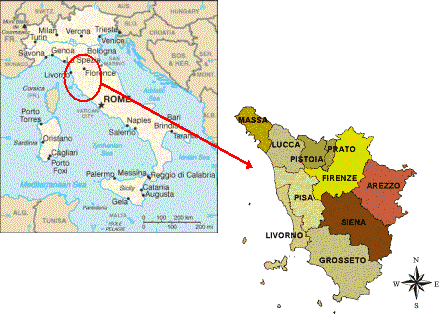 |
ASSESSMENT OF FEEDSTOCK POTENTIAL IN TUSCANY AND IN ITALYThe objective of this study is the assessment of the availability of biomass resources for potential pyrolysis plants to be located in Tuscany.
Tuscany is one of the twenty administrative regions of Italy; it is located in the centre of the country and, with a total surface of nearly 23000 km2, it has a population of approximately 3500000 inhabitants.
With a forest surface extending for nearly 860000 ha, it is one of the Italian regions with the highest forest index (corresponding to about 37% of the region's territory).
The biomass availability assessment has been carried out by means of GIS-based planning tool.
GIS is an acronym for Geographical Information System. Geographically referenced maps and databases allow to evaluate the localisation of resources, their typology and accessibility. The GIS tool has been developed in partnership with European partners in the frame of EC funded projects.
The Tuscany Forest Inventory (IFT), a database related to land use, has been used for biomass source localisation. Additional information have been included considering some geographical constraints in order to exclude areas. In the case of forestry residues for example the applied criteria have been: a slope lower than 70%, an easy accessibility and a land slightly affected or free from erosion.The biomass resources taken into account in this study have been:
- Forestry residues;
- Wood industry (sawmills, semi-finished products, carpentries and furniture factories) residues;
- Agricultural tree crop residues;
- Agricultural herbaceous residues.The potential has been estimated considering the accessibility of the productive areas and the competing markets.
The most important source of biomass for energy purposes in Italy is constituted by forestry residues, resulting from silvicultural operations, such as thinning, cleanings, logging and final fellings aimed at producing firewood or industrial wood.
The Tuscany region forest areas can provide over 2845000 tons per year of woody biomass.
The considered amount of forestry residues has been the one ecologically sustainable, strictly related to the forestry regeneration capacity.
From this amount 2265000 tons are for firewood or timber/industrial wood while forestry residues are about 580000 tons/year.
The wood industry sector constitutes an important source of biomass too. Statistical data have been used to estimate a residue production of 177500 tons/year.
A survey of the pellet and wood chip market in Tuscany has been carried out, but it can’t be seen as a really competing market as the wood residue consumption for pellet and wood chip production is not lower than 2.5%.
With regard to agricultural tree crop residues that is woody residues derived from the maintenance, mainly pruning, of tree crops, the following tree crops have been considered for Tuscany: vineyards, olive trees, fruit trees and poplar trees.
For what concerns agricultural herbaceous residues only straw residual from cereal cultivation has been considered. The animal feeding/breeding has been taken into account into the calculation as a competing market (about 50% of straw residues considered available for energy production).
Summarizing the estimated total amount of biomass resources currently available for energy purposes and therefore also for pyrolysis oil production is 1362500 tons/year:
Biomass sources Tons/year Forestry residues 579500 Wood industry residues 177500 Agricultural tree crop residues 310500 Agricultural herbaceous residues 295000 Total 1362500
A further estimate of the biomass potential for pyrolysis oil production has been performed for Italy, based on data obtained for Tuscany, on a survey of data on biomass availability in Italy and on the information on the land use from the GIS and the CORINE Land Cover 2000 layers.
It is important to highlight that an evaluation performed at such a large scale has a great uncertainty, depending on a great heterogeneity of the Italian territory, of the climate and the land use.
The biomass amount potentially available for pyrolysis oil production can be calculated subtracting from the total estimated biomass available for energy purposes the one actually consumed for heat and electricity production as shown in the following table:
MTOE Million Tons/Year TJ
Total biomass available for energy purposes4.82 12.82 202149 Biomass consumed for heat and electricity production 1.19 3.16 49786 Biomass available for pyrolysis oil production 3.64 9.66 152363


